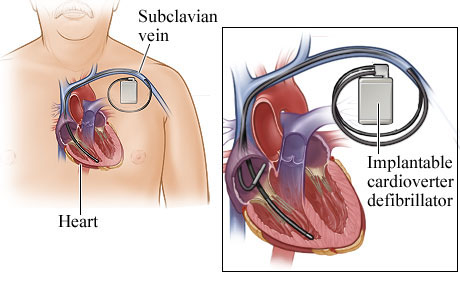Implantable cardioverter-defibrillator (ICD)
What is an ICD
An implantable cardioverter-defibrillator (ICD) is a device designed to quickly detect a life-threatening, rapid heartbeat coming from the bottom chamber of the heart. It tries to convert an abnormal rhythm back to normal by delivering an electrical shock to the heart. This action is called defibrillation. An ICD can prevent sudden cardiac death.
An ICD is made of several parts:
• pulse generator sends the powerful shock to the heart. It runs on batteries. The generator is implanted under the skin, usually on the upper left side of the chest.
• An electronic switchboard (circuit) tells the device when to "fire" the shock.
• An electronic switchboard (circuit) tells the device when to "fire" the shock.
Electrodes (wires) go through the veins of the heart and connect the heart to the rest of the device. The wires sense the heart beat and carry the shock to the heart muscle.
All ICDs have a built-in pacemaker. Pacing may be necessary to support the heart in some instances, for example, after a shock, or during a very slow heart beat. The pacemaker also allows the device to correct some rapid heartbeats by pacing even faster for a short period of time. Also, all of today's bi-ventricular pacemakers can work as an ICD.
The ICD continuously monitors the heartbeats to make sure they are normal. It only delivers a shock to the heart when it senses a life-threatening rhythm.
During the implantation of a pacemaker-type ICD, electrodes are inserted through the veins into the heart. The pulse generator is surgically buried under the skin of the chest, generally below the left collarbone.
Who needs an ICD?
An ICD can help prevent sudden death in those who have ventricular fibrillation (VF) or ventricular tachycardia (VT). Both of these conditions can make the heart stop pumping blood, which can cause you to suddenly pass out (lose consciousness) or even die. VF and VT are emergency situations that require quick medical treatment. Cardioversion (external defibrillation) can be used to shock the heart rhythm back to normal. People who may receive an ICD include but are not limited to those who have:
• Survived a cardiac arrest due to VF
• Life-threatening episodes of VT
• Survived a heart attack, but whose heart remains weak
• Problems with the heart muscle, including dilated cardiomyopathy and hypertrophic cardiomyopathy, especially when unexplained fainting episodes have occurred
• Reduced pumping function of the heart
Occasionally, an electrophysiological study (EPS) is needed to make sure you can have or need an ICD implanted.

What to expect after ICD implementation
Persons who have an ICD implanted rarely stay in the hospital longer than 1 day. Patients quickly return to their normal activity level. Full recovery occurs in about 4 to 6 weeks.
When you leave the hospital, you will be given a card to keep in your wallet. This card lists the details of your ICD and has contact information for emergencies. You should always carry this wallet card with you. You will need to make regular visits to the doctor so the ICD can be monitored. The doctor will check to see if the device is properly sensing the heartbeat, how many shocks have been delivered, and how much power is left in the batteries. The ICD batteries are designed to last 5 to 8 years. When they are about to run down, the ICD generator must be replaced. This requires minor surgery.
The ICD generator is metal and will be detected by metal detectors such as those in airports or public places with safety checks. For air travel, public events, and admission to certain areas you will need to show your wallet card to the security personnel to prevent setting off any alarms. People with ICDs need to follow their doctor's advice about medication, diet, and exercise.
Benefits of the ICD
Among patients considered good candidates for an ICD, the ICD has shown to prolong life by preventing sudden death. The device provides peace of mind, relieving concerns about fainting spells and risks of death. Most patients adapt to the uncertainty of the shocks. Most patients also can resume driving.
Potential Risks of ICD
Surgery is needed to implant the ICD. Risks of surgery include but are not limited to pain, infection, and bleeding. Additionally, ICD implantation can cause dangerous and life-threatening heart rhythms, injury to the heart and lungs, and death. These complications are very rare.
One problem with an ICD is that it sometimes delivers shocks when you do not need them. Even though a shock lasts a very short time, you can usually feel it. Every shock you feel should be notified to your doctor. The settings of the ICD may need to be adjusted or your medications may need to be changed.
ICD problems can sometimes be prevented by programming the device to sound an alert when there is a problem. This can be done by your electrophysiologist. If you hear your ICD alert, you should immediately call your electrophysiologist.
Acknowledgements
Heart Rhythm Specialists of South Florida gives special thanks to the National Library of Medicine, Wikipedia and National Heart Lung and Blood Institute whose Web sites aided in the research of the patient educational material provided above.






